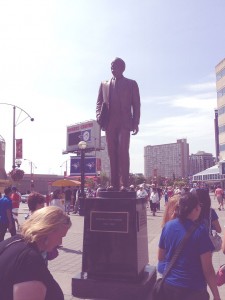Lesson Two - Social Inequality in Canada
Overview
Introduction to Society Inequality in Canada

The Ted Rogers statue with Ted Rogers Centre for Heart Research in the background.
Who gets monumentalized in Canada, and who gets forgotten?
When he died in 2008, Ted Rogers Jr., then CEO of Rogers Communications, was the fifth-wealthiest individual in Canada, holding assets worth $5.7 billion. In his autobiography (2008) he credited his success to a willingness to take risks, work hard, bend the rules, be on the constant look-out for opportunities, and be dedicated to building the business. In many respects, he saw himself as a self-made billionaire who started from scratch, seized opportunities, and created a business through his own initiative.
The story of Ted Rogers is not exactly a rags to riches one, however. His grandfather, Albert Rogers, was a director of Imperial Oil (Esso) and his father, Ted Sr., became wealthy when he invented an alternating current vacuum tube for radios in 1925. Ted Rogers Sr. went from this invention to manufacturing radios, owning a radio station, and acquiring a licence for TV broadcasting.
However, Ted Sr. died when Ted Jr. was five years old, and the family businesses were sold. His mother took Ted Jr. aside when he was eight and told him, “Ted, your business is to get the family name back” (Rogers, 2008). The family was still wealthy enough to send him to Upper Canada College, the famous private school that also educated the children from the Black, Eaton, Thompson, and Weston families. Ted seized the opportunity at Upper Canada to make money as a bookie, taking bets on horse racing from the other students. Then he attended Osgoode Hall Law School, where reportedly his secretary went to classes and took notes for him. He bought an early FM radio station when he was still in university and started in cable TV in the mid-1960s. By the time of his death, Rogers Communications was worth $25 billion. At that time just three families, the Rogers, Shaws, and Péladeaus, owned much of the cable service in Canada.
At the other end of the spectrum are the Aboriginal gang members in the Saskatchewan Correctional Centre who we discussed in Chapter 1 (CBC, 2010). The CBC program noted that 85 percent of the inmates in the prison were of Aboriginal descent, half of whom were involved in Aboriginal gangs. Moreover the statistical profile of Aboriginal youth in Saskatchewan is grim, with Aboriginal people making up the highest number of high school dropouts, domestic abuse victims, drug dependencies, and child poverty backgrounds. In some respects the Aboriginal gang members interviewed were like Ted Rogers in that they were willing to seize opportunities, take risks, bend rules, and apply themselves to their vocations. They too aspired to getting the money that would give them the freedom to make their own lives. However, as one of the inmates put it, “the only job I ever had was selling drugs” (CBC, 2010). The consequence of that was to fall into a lifestyle that led to joining a gang, being kicked out of school, developing issues with addiction, and eventually getting arrested and incarcerated. Unlike Ted Rogers, however, the inmate added, “I didn’t grow up with the best life” (CBC, 2010).
How do we make sense of the divergent stories? Canada is supposed to be a country in which individuals can work hard to get ahead. It is an “open” society. There are no formal or explicit class, gender, racial, ethnic, geographical, or other boundaries that prevent people from rising to the top. People are free to make choices. But does this adequately explain the difference in life chances that divide the fortunes of the Aboriginal youth from those of the Rogers family? What determines a person’s social standing? And how does social standing direct or limit a person’s choices?
The French sociologist Pierre Bourdieu (1930-2002) defined ones habitus as the deeply seated schemas, habits, feelings, dispositions, and forms of know-how that people hold due to their specific social backgrounds, cultures, and life experiences (1990). Bourdieu referred to it as ones “feel for the game,” to use a sports metaphor. Choices are perhaps always “free” in some formal sense, but they are also always situated within one’s habitus. The Aboriginal gang members display a certain amount of street smarts that enable them to survive and successfully navigate their world. Street smarts define their habitus and exercise a profound influence over the range of options that are available for them to consider — the neighborhoods they know to avoid, the body languages that signal danger, the values of illicit goods, the motives of different street actors, the routines of police interactions, etc. The habitus affects both the options to conform to the group they identify with or deviate from it. Ted Rogers occupied a different habitus which established a fundamentally different set of options for him in his life path. How are the different lifeworlds or habitus distributed in society so that some reinforce patterns of deprivation while others provide the basis for access to wealth and power?
As Bourdieu pointed out, habitus is so deeply ingrained that we take its reality as natural rather than as a product of social circumstances. This has the unfortunate effect of justifying social inequalites based the belief that the Ted Rogers of the world were naturally gifted and predisposed for success when in fact it is success itself that is “predisposed” by underlying structures of power and privilege.